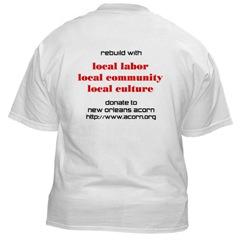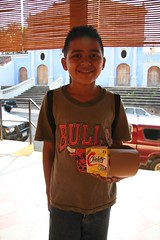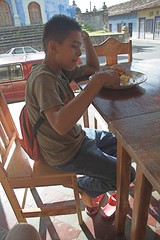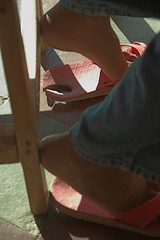This is the price for the jeans you wear
The terms of engagement for foreign investors are astonishingly attractive and have generated a veritable maquiladora boom. One zona franca's website explains this "unique opportunity":
Of primary concern to Nicaraguan lawmakers is the 60% rate of unemployment. Because of this, free zone operators enjoy laws that provide them with maximum freedom and benefits. For ease of operation and profitability, Nicaragua is your best alternative.Nicaragua's zonas francas (ZFs) are dominated by clothing manufacturers (~60%) from Korea, Taiwan and the United States. The next largest category (tobacco factories) occupies just 11% of the zonas.
- All Nicaraguan products are NOT subject to quotas
- Unrestricted currency conversion
- Duty free importation of all production machinery, other equipment, fixtures, spare parts, raw material and supplies.
- Import and export shipments cleared in less then one day with minimum documentation.
- No government income, sales or corporate taxes or fees.
- Unrestricted repatriation of profits and capital at any time.
- Low cost skilled and unskilled labor.
- Ample supply of trainable and productive labor.
So what are Nicaraguans getting for these investment-friendly rules? According to the National Commission of Zonas Francas (Comisión Nacional de Zonas Francas; CNZF), the goals are clear: "promoting the generation of employment, foreign investment, the export of non-traditional products, the acquisition of technology and the reactivation of our foreign commerce."
Truth be told, most of these things have happened, but what is less clear is how these have helped the Nicaraguan economy or the country's endemic un(der)employment. Between 2000 and 2004, the CNZF reported that Nicaraguan exports have averaged a modest 2.3% growth per year. But this masks the far more rapid rise in exports from ZFs (average growth of 9% per year) and the decline in Nicaragua non-ZF exports during that same period (average decline of 1.6% per year). Given that ZF production generates almost no real income for the state, it is unclear who benefits from this growth.
There is, of course, new employment. ZFs now employ about 65,000 people and they are supposed to earn the minimum wage of $.40 per hour. A number of studies, however, suggest that this wage is not always paid and that overtime laws are frequently ignored even though most ZF employees work between 9 and 14 hours per day. Moreover, the working conditions are insufferably hot and noisy, with people on their feet all day and often lasting only a few years because of repetitive stress injuries. Labor organizing is extremely difficult and activist workers are frequently fired and blacklisted. [For excellent Nicaraguan analyses of ZFs, working conditions, and economic opportunities, take a look at Jon Ander Bilbao, Olga Rocha and Magdalena Mayorga, "Sébaco's Sweatshop: Dreams, Realities and Frustrations," Envío (Apr. 2004) and the MEC's numerous publications on women and labor conditions, especially Diagnóstico Seguridad Ocupacional (Word file).] Still, let's take the most generous terms for these employees' contribution to Nicaragua's economy. Assuming that 65,000 workers actually make the minimum wage and work 14 hours per day, 6 days a week, 48 weeks per year, their wages would total about US$104 million. That's about .84% of Nicaragua's GDP. Of course, wages get spent and have what economists call a "multiplier effect" as they move through the economy. Even if we provide a generous multiplier of 3, that still only brings us to 2.52% of GDP.
Even if ZFs could double in the next decade (a questionable assumption), the value added benefits to Nicaragua remains fairly limited. It's not that work isn't good or important, but whether the race to the bottom of absolute corporate freedom will produce the desired benefits. Sixty percent of ZFs produce clothing, but Nicaragua provides none of the cotton. It's cotton industry, which boomed in the 1950s, has all but died in since 1990. So what "value added" do the ZFs provide? Labor and...what?
Since 2000, growth in real GDP per capita has been paltry and erratic, registering an average of .22% growth per year between then and 2004. Perhaps out of desperation, production of staple foodstuffs has skyrocketed. During this same period of grinding poverty, the bean harvest has risen each year by an average of 13.5%, while corn production has average 16% yearly growth (calculated from Economist Intelligence Unit, Nicaragua Country Profile, Main Report 2005). Compared to its Central American neighbors, Nicaragua's internal agricultural production has always been fairly robust, and that, along with the outlet of migration to Costa Rica and the U.S. may be the only things keeping Nicaragua's economic woes from spilling into the streets.
ZFs are not a development strategy. Neither is free trade. They are tools and they can be used to produce desirable affects, but only if there is a viable state that is able to manage and control the potentially destructive qualities of these policies. Corporations are machines of profit, despite being inhabited by humans with souls. Let loose without control, they crush the weak, like elephants walking on ants. Yet the lie of these things is put forth every day. Take, for example, the self-congratulatory cant of Deputy Secretary of State Robert Zoellick (who was just in Nicaragua to bully local politicians into remembering who's the boss): "CAFTA is the right thing to do for democracy." Not to put too fine a point on it, but that's bullshit. (If you really want to wallow in it, read the entirety of Zoellick's words in his Washington Post op-ed piece. After re-reading it, I still can't tell if he's willfully dissembling or just plain ignorant.) Nicaragua is unbelievably poor and neither free trade nor the American big stick is going to fix that.
So, what to do? There are lots of options and none of them is going to change the world overnight. You can buy from non-sweatshop producers. When you purchase clothes from Nicaragua (or any other country), you can write to the manufacturer and ask them to report to you on the conditions of workers in the factories they buy from. They might lie to you, but they also will know you're watching. You can avoid shopping at and support groups like Co-op America that work for a more just and equitable world. You can donate to organizations like the National Labor Committee, to fight for changes in legislation and to promote fact-finding investigations that put the spotlight on poor wages and harsh working conditions. You can march to the barricades. Welcome to the globe.










